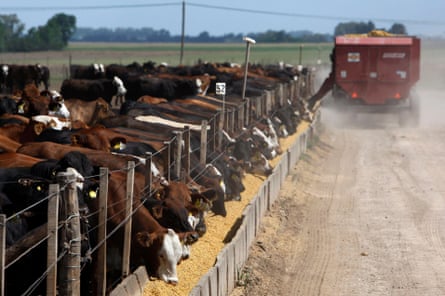It was a confronting moment for a vegetarian. First, a pork meatball and then slices of bacon, balanced in a sort of mini BLT, were served to eat by beaming, expectant hosts. The meat even came from a named pig, an affable-looking swine called Dawn.
With some trepidation, I sliced into the meatball and ate it. I then took a nibble of the bacon. It was my first taste of meat in 11 years, a confounding experience made possible by the fact that Dawn, gamboling in a field in upstate New York, did not die for this meal.
Instead a clump of her cells were grown in a lab to create what’s known as “cultivated meat”, a product touted as far better for the climate – as well as the mortal concerns of pigs and cows – and is set for takeoff in the US.
“A harmless sample from one pig can produce many millions of tons of product without requiring us to raise and slaughter an animal each time,” said Eitan Fisher, founder of Mission Barns, a maker of cultivated meat that invited the Guardian to a taste test in an upscale Manhattan hotel. The meatball was succulent, the bacon was crisp and, even to a vegetarian, both had the undeniable quality of meat.
“We got that sample from Dawn and she’s living freely and happily,” said Fisher, whose company has identified a “donor” cow, chicken and duck for future cultivated meat ranges. “This industry will absolutely be transformative to our food system as people move toward consuming these types of products.”
Mission Barns is one of about 80 startup companies based around San Francisco’s Bay Area now jostling for position after one of their number, Upside Foods, became the first in the country to be granted approval by the Food and Drug Administration (FDA) in November, a key step in allowing the sale of cultivated meat in the US.

More than $2bn has been invested in the sector since 2020 and many of the new ventures aren’t waiting for regulatory approval before building facilities. In December, a company called Believer Meats broke ground on a $123m facility in North Carolina it claims will be the largest cultivated meat plant in the world, set to churn out 10,000 tons of product once operational.
So far cultivated meat – the nascent industry settled on this name over lab-grown or cellular meat – has only started selling in Singapore, where another Bay Area contender, called Eat Just, was given the green light to sell chicken breast and tenders in 2020. But the “world is experiencing a food revolution”, as the FDA put it, with the rise of cultivated meat holding the promise of slashing the meat industry’s ruinous planet-heating emissions and shrinking its voracious appetite for land, as well as sparing livestock the barbarity of factory farming.
“We know we can’t really hit the goals in the Paris climate agreement without addressing meat consumption and we think alternative proteins are the best way to address that,” said Elliot Swartz, lead scientist on cultivated meat at the Good Food Institute (GFI) who envisions a sort of “all the above” approach where cultivated meat, plant-based offerings like Impossible burgers and simply giving up the pork chops and steaks help soften the impact of a growing, and potentially disastrous, global appetite for meat.
The raising and slaughter of livestock is responsible for more than half of the greenhouse gas pollution of the entire food sector, which in itself is estimated to contribute around a third of total global emissions. Faced with the need to reach “peak meat”, cultivated meat has been pushed forward as a solution as it can cut emissions by around 17% for chicken and up to 92% for beef, the meat that weighs heaviest on the planet, GFI’s research has found.
Vast areas of land, much of it deforested for grazing and vulnerable to outbreaks of zoonotic diseases, meanwhile, could be freed up if meat is instead conjured up in the sort of 30,000 sq ft facility Mission Barns operates. Eating something that’s not been fed with copious amounts of antibiotics is of particular public appeal, too, the company’s research has found.
“The production process is more efficient, you have significantly less feed material to get the same amount of calories out and you have a huge opportunity to restore ecosystems and slow biodiversity loss,” said Swartz. “It enables a way to mitigate all of these hard, sticky global challenges.”
A report last week identified a rise in plant based meat alternatives as one of three “super tipping points” that could trigger a cascade of decarbonisation across the global economy, alongside boosting electric vehicles and green fertilisers. It found a 20% market share by 2035 would mean 400m-800m hectares of land would no longer be needed for livestock and their fodder, equivalent to 7-15% of the world’s farmland today, the report estimated.

This challenge is particularly stark in the US, the world’s largest producer of beef and chicken and the second largest producer of pork, a country where meat-eating is deeply embedded through ingrained habit or the lack of available, affordable alternatives to the point that each American eats more than 260lb of meat each year, on average, a figure that appears to be edging up.
An excited, yet brief, craze over Impossible and Beyond Meat has underscored American desires for actual meat, rather than plant-based imitations. “In consumer research a lot of people say, ‘I’m not eating that plant stuff, I don’t care how good it tastes,’” said Swartz.
The goal for Mission Barns, which hopes to get its own FDA approval shortly and has a range of bacon, meatballs and sausages ready to distribute, is to “appeal to folks who love eating bacon and who love eating meatballs”, according to Fisher, who himself has been vegetarian for more than a decade. “Whether it’s consciously or subconsciously we crave and desire the flavor of animal meat. Plant-based alternatives come close to mimicking them.
“But for folks who want that real flavor, I think giving them real pork is definitely the way to go. If we want something that tastes like bacon, it’s not going to be enough to have a piece of tempeh and call it bacon.”
Since launching in 2018, Mission Barns has embarked on a PR offensive while developing its product, gathering information for regulators and raising money (investors put $24m toward a “pilot plant” in 2021). A sprawling kitchen that would look at home on TV show set has hosted lawmakers and potential customers (Steny Hoyer, a prominent congressional Democrat, was apparently a huge fan of the bacon) and a handful of outlets have agreed to stock its products once they are approved for sale.
Many of the emerging cultivated meat ventures have some sort of niche – companies that aim to sell lab-grown sushi-grade salmon, or bluefin tuna or even fois gras – and Mission Barns’ is one of efficiency, by growing animal fat rather than more laborious and costly muscle and tissue. The fat, which has proteins and seasoning added to it, is created through growing cells in sturdy bioreactors, which replicate the growth of an animal.
The use of these cultivators, which are more usually deployed by the biopharmaceutical industry to manufacture drugs, presents an issue for cultivated meat because they more typically create small batches at high cost, whereas the food industry requires this equation to be reversed. Creating the first lab-grown burger cost $330,000 back in 2013, and while there have been improvements, the price tag is still a barrier to quickly scale production to rival the traditional meat industry in the short term. Eat Just has a chicken nugget that it said in 2019 costs $50 to make, though its prices have now come down.
The process can also be energy intensive, as meat cultivation has to replicate the heating and cooling of an animal, which will require running on a renewable-heavy grid to avoid adding to emissions. But beyond the practical obstacles the onset of cultivated meat raises broader questions. Will the public see any reason to switch to this newly formed flesh? And will this change the concept of what it means to eat ethically?

The intended audience for cultivated meat may be those who eat meat at least once a day, to help them sidestep to a more environmentally friendly option without giving up flesh entirely, but the advent of meat from a lab does pose philosophical questions for vegetarians.
If you don’t eat meat because of animal welfare or climate reasons, what happens when these issues are stripped away from the food? How much is being a vegetarian about those sort of values, beyond the act of eating meat itself? I pondered this as I dealt with a sort of claggy, oily feeling in a mouth unused to eating meat. Others are less conflicted.
“I fully plan on eating this stuff when it’s more available in the US,” said Swartz, who has been a vegetarian for the past four years. “People don’t give up meat because it tastes bad, it’s other motivations. I think we will need some new word, like cultivarian, or something like that.”

 1 year ago
224
1 year ago
224










 English (US)
English (US)